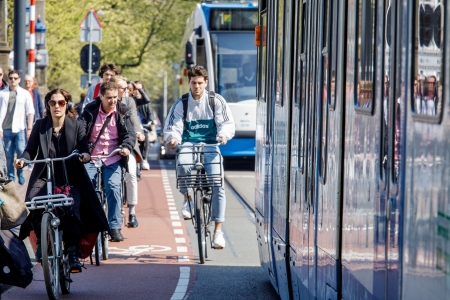Several measures may improve road safety of public transport. They may be subdivided into three categories: infrastructure, vehicle, and behaviour.
Infrastructure
Sustainable Road Safety advises to align traffic flows and modes of transport in speed, direction, mass, size and degree of protection (also see SWOV fact sheet Sustainable Road Safety). The objective is to design the traffic environment in such a way that serious crashes are prevented, and to reduce injury severity when crashes are inevitable. The weight and size of public transport vehicles requires them to be separated from slow and vulnerable road users to a maximum extent. This will be achieved by creating well-situated, designated bus lanes and tram tracks. At locations where the road is shared, reliable and timely tram alert facilities could also improve safety [7]. In principle, buses should be allowed to stop on the carriageway on low-speed roads. Each bus stop should, however, be examined for road safety consequences (for example: does a stop location leave enough space for other traffic to pass?). If not, creating a bus bay may be a solution [32].
Masking effects along a track or road which may cause public transport drivers to overlook vulnerable road users should be remedied. Crossing a bus lane or tram track may also be discouraged (by a gravel or grass bed between tram tracks and/or fences between tracks/bus lanes) [5] [6].
Finally, infrastructure maintenance is also important. When servicing tracks, switch breaks and defects or track twists should be noticed and repaired on time [33] [34]. Such anomalies could result in derailments and, thus, in crashes.
Vehicle
Appropriate design of (the front of) public transport vehicles could limit injury severity for vulnerable road users. A pedestrian will be left with fewer injuries if the tram front does not have protruding elements, if there is enough space underneath the tram and if the tram has underrun protection [16]. Passengers could be protected by chairs that do not have protruding or sharp elements, and by soft and yielding arm and back rests [4].
Public transport vehicles are often equipped with systems to reduce crash risk. Trams are equipped with an automatic sanding system that sands the rails in case of an emergency stop, which increases friction and reduces braking distance [14]. Truck drivers are supported by systems for blind spot detection and signalling, which allow them to detect cyclists and pedestrians around the blind spot of their trucks [35]. These systems could also increase the road safety of (public transport) buses and trams. Finally, automatic pedestrian detection could improve the road safety of buses and trams as well [36].
Behaviour
For the safety of public transport passengers, drivers should avoid manoeuvres that increase the risk of a fall, such as sudden acceleration, taking sharp turns, and heavy braking [25]. Misconduct by road users on level crossings should be discouraged and fined with the help of more smart cameras and by drawing attention to the dangers by a public service campaign (also see the question What measures are taken to improve road safety around railway tracks?).
